Positive Health Online
Your Country

Holistic Integrated Cancer Support Therapy
by Nicola J Bradbury(more info)
listed in cancer, originally published in issue 68 - September 2001
Introduction
The Centre at Woodside grew from the idea of providing a patient-centred holistic health-care programme in a peaceful safe setting, conducive to healing and the relief of stress that so overshadows our present way of life. The Centre serves as a catalyst for change – change of heart, change of attitude and change of living patterns. The foundation for all such change is a willingness to become responsible for one's own health and well-being. Many of us have been brought up to accept that the way to restore health involves only the taking of drugs and other conventional medical treatments. The habits of a lifetime are not easily changed and it naturally takes time and help to adjust to a new, gentle approach.
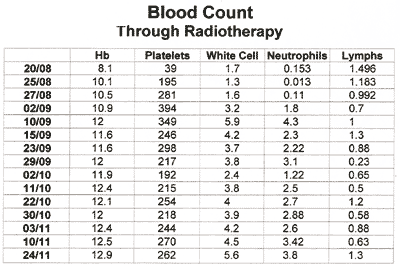
Blood count reading of female patient, aged 12 years receiving radiotherapy for
Ewing's Sarcoma, also taking herbal support therapy at the same time
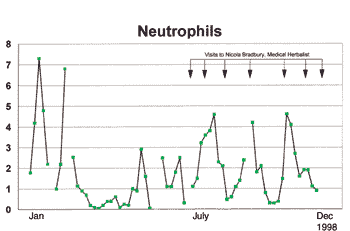
Blood count reading of female patient, aged 12 years receiving radiotherapy for
Ewing's Sarcoma, also taking herbal support therapy at the same time
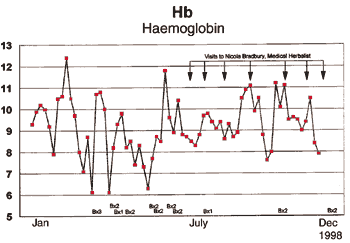
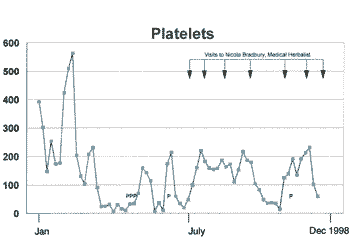
This is not a new concept, but was being expressed by Plato in Chronicles 156e:
"The cure of the part should not be attempted without treatment of the whole, and also no attempt should be made to cure the body without the soul, and therefore if the head and body are to be well you must begin by curing the mind; that is the first thing… For this is the great error of our day in the treatment of the human body; that physicians separate the soul from the body."
Cancer Support Therapy
The need for a cancer support therapy regime to work alongside conventional treatments for cancer administered by medical doctors and oncologists, such as chemotherapy and radiotherapy, has evolved during clinical observations of patients experiencing fear, anger and a general feeling of helplessness once they receive a diagnosis of cancer by their doctor.
The aim of complementary support therapy for cancer is not to encourage false hope, but to create a feeling of control and personal responsibility in the lives of the patients and their families so that they can focus their attention on a positive daily programme which will enhance their quality of life, in many cases increase their longevity, and in some instances even contribute to a remission from the illness.
The cancer support therapy has developed after working with cancer patients since 1987. The programme involves a bio-acoustic sound profile of the patient's voice. This computer program is able to measure the relative functioning of various areas of the patient's body, such as circulation and oxygenation of the system, digestive and respiratory function, elimination, detoxification and nutrient absorption abilities of the body. A sound graph is compiled during the initial case history session, providing a broad-spectrum picture of the overall health of the patient. An analysis of this allows for focused therapy in those areas that require the most support. This sound graph can be performed at regular intervals to show areas of improvement and to restructure emphasis of treatment
Counselling
Counselling is given to provide emotional support for the patients and their families. This allows the patients to express the anger, grief and fear that follow the shock of a cancer diagnosis. This is carried out in a safe, confidential setting with empathy, compassion and constructive support at a time when the patient is most vulnerable. It also frees the patient from the anxiety of feeling that they have to suppress negative emotions to shield their close family from more stress. Many patients have expressed how invaluable they view this opportunity to 'let off steam'.
The extensive research carried out by Dr Elizabeth Kubler-Ross has shown that even terminal patients find a sense of peace, acceptance and release by receiving emotional support at this time by professional counselling in a sensitive and empathic manner. A holistic approach takes into consideration the total person – mind, body and spirit – and research shows that disharmony in any or all of these areas results in dis-ease or disease.
Dr Candace B Pert, an internationally recognized pharmacologist, has brought to the attention of the orthodox medical world the importance of the mind-body link and its effects on the immune system. She is a member of the American College of Neuropsychopharmacology with an international reputation in the field of neuropeptide and receptor pharmacology and chemical neuroanatomy and has lectured worldwide on her theories on emotions and mind-body communication.
Herbal Medicine
Non-toxic and scientifically researched and tested herbal treatments are used to support the patients' immune system and to help with detoxification and elimination, thereby giving the body support during chemotherapy and/or radiotherapy recommended by their oncologist. This has proved effective in improving platelet levels and increasing blood count levels. (See blood count graph (following page) of a female patient, aged 12 years, using cancer support therapy while undergoing a course of radiotherapy for Ewing's sarcoma.)
Side effects such as nausea and fatigue, which are common with many forms of chemotherapy, are greatly reduced by herbal medicine support therapy, enabling patients to have more energy to cope with their daily life. Transdermal herbal creams and gels are used as part of the holistic treatment programme to provide immune system support for patients who may be unable to take oral herbal medicine. These have proved very effective in recorded case histories (see patient G in case studies).
Blood count reading of female patient, aged 12 years receiving radiotherapy for Ewing's Sarcoma, also taking herbal support therapy at the same time
Micronutrient Therapy
Part of each patient's integrated complementary support programme is micronutrient diet therapy. This is a system of nutritional support using microelement technology devised by Professor Charles Beijns. Professor Beijns states that "Micro-Element Technology has been developed on the principle that when the vibration or makeup of the cell's structure has been in some way corrupted, it can be restored to its natural frequency and integrity by the transmission to that cell of the correct micro-element message." Clinical assessment of the effectiveness of microelement technology was carried out on children exposed to the radiation of Chernobyl. The results showed a significant improvement in their immune function.
Microelement therapy is invaluable because many cancer patients suffer extreme weight loss and microelements are easily absorbed, are in solution and are tasteless and therefore easy to take. They are totally safe for use with children and the elderly.
Diet
Guidance is provided based on extensive scientific research into the appropriate foods that support the immune system and give nourishment, thus allowing the body to function more efficiently and providing increased energy and mental clarity.
An adjunct treatment used at the clinic is supplementation with arabinoxylane, from rice bran (MGN-3), a natural killer cell booster. MGN-3 has been extensively researched by Dr Ghoneum at the Department of Immunology at Drew University in Los Angeles. His findings were as follows:
"Arabinoxylane, from rice bran (MGN-3), was examined for its augmentory effect on human natural killer cell activity in vivo and in vitro. Twenty-four individuals were given MGN-3 orally at three different concentrations: 15, 30, and 45mg/kg/day for 2 months. Peripheral blood lymphocyte-natural killer cell activity was tested by 51 CR-release assay against K562 and Raji tumor cells at 1 week, 1 month and 2 months post-treatment and results were compared with baseline natural killer activity. Treatment with MGN-3 enhanced natural killer activity against K562 tumor cells at all concentrations used."[1,2]
The blood count graphs show how inclusion of MGN-3 in the holistic regime can improve blood count results even while undergoing radiotherapy.
Environmental carcinogenic pollutants and toxic household and cosmetic products are avoided and eco-friendly products are recommended. Also a totally organic diet is encouraged whenever possible. Guidance sheets and reading references are available at the clinic for friends and family who want to take supportive action around the home, creating a safe environment.
Reflexology
A part of the cancer patient's holistic programme provided by the clinic is reflexology, a therapy based upon the principle that there are reflexes in the feet corresponding to each organ and all parts of the body. Stimulating these reflexes properly can help circulation and can be used primarily for relaxing tension. The combination of reflexology and essential oils is extremely effective at a physical and mental level and is now used successfully in many hospices.
Vibrational Medicine
Vibrational medicine is a vital part of the patient programme at Woodside. This includes chakra balancing and the use of kinesiology (a method of muscle testing) to discover weaknesses in the patient's chakra system that correlate at a physical level to their endocrine system. Electromagnetic field balancing is an extremely important part of the cancer support therapy, as research over many years into the biological effects of earth radiation has shown harmful influences on patients' health.
Each patient is checked for electromagnetic field disturbances that may have resulted from environmental sources, such as exposure to electrical sub-stations, pylons, long hours in front of a computer screen, geological faults and earth energy disturbances caused by mining, underground streams and natural earth radiation.
Charts and plans are drawn of the patient's living and work environment and, using dowsing and muscle-testing, areas of electromagnetic field imbalances are detected so that a patient may move their bed or desk chair from an energetically draining location to a strengthening position. This simple discovery during a treatment assessment can have a profoundly positive effect upon the patient's energy levels, sleeping patterns, mental attitude and over all immune function.
The use of flower remedies is part of their support therapy regime. The most commonly known flower remedies are the Bach flower remedies. These are a simple and natural method of establishing equilibrium and harmony through the personality by means of wild flowers discovered by Edward Bach. Since the work of Dr Bach, the flower remedy repertoire has grown and encompasses flower remedies from around the world.
A long-continued worry or fear will deplete the individual's vitality; he/she will feel out of sorts, below par, and then the body loses its natural resistance. As peace and harmony are achieved, unity returns to mind and body, closing the circuit as it were, and allowing the life force to flow freely again, thus providing the body with a chance to produce its own natural healing. Flower remedy profiles are made up individually for patients at the Centre as part of their holistic treatment programme.
All patients have the option of receiving healing in the form of reiki healing or spiritual healing. This helps a person to return to a wholeness of being. The healer has sought an attunement with the Source and then becomes a channel through which the energies flow to the patient. These can manifest through the hands of the healer as a warmth or sometimes as a coldness or even as a slight vibration. Healing not only affects the physical body but also works at an emotional and spiritual level.
All treatment programmes are created to meet each patient's unique needs using kinesiology. This ensures that a balance of physical, mental and spiritual needs is maintained as the patient undergoes their orthodox treatment with their doctor. All patients are encouraged to inform their doctors and oncologists about their holistic regime, so that an atmosphere of co-operation and teamwork is maintained in providing for the patient a better quality of life during their fight with cancer.
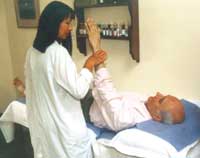
Patient receiving kinesiology
Patient Case Studies
Case Study 1 – Patient A
In July 1997, patient A was referred for cancer support therapy by his GP. He was presenting with advanced prostate cancer with bone metastases. His cancer was inoperable and he was put on Zoladex treatment by the hospital urologist. The prognosis was considered poor, the normal life expectancy being eighteen months from diagnosis in advanced prostate cancer. He went through a thorough case history screening and was placed on herbal support therapy juices, the doses of which were monitored each month and adjusted according to his needs. He was given microelement nutrients and MGN-3 immune booster support. Flower remedies and counselling were given for his bouts of depression. His blood pressure and blood oxygen levels were monitored regularly each month and nutritional advice was given. He was screened for both geopathic stress and environmental factors that were affecting his health, and necessary adjustments were made willingly by the patient. Six-and-a-half years later he is enjoying his retirement, has moved house, plays bowls regularly, drives his car and has a good quality of life. He continues to have regular monthly check-ups by his GP and monthly visits for his cancer support therapy.
Case Study 2 – Patient J
In 1998 patient J, aged 43 years, presented with adrenal cortical cancer (ACC). She was given the full computer screening and placed on a cancer support therapy regime. This patient is unusual because she elected to have surgery but declined to take the orthodox prescribed chemotherapy recommended by her oncologist because of the side effects which she and her husband researched on the Internet. Her testimonial is as follows:
"I was diagnosed with ACC in October 1998. By chance, we heard about Nicola Bradbury who I first visited around 3 weeks after my first tumour was removed. I had regularly seen a homeopath, but this was the first experience of any of the methods and therapies employed by Nicola. She put me on a range of supportive juices and Bach Flower drops. I still remember the feeling of need for the flower drops if they ran out before I had another appointment. She also recommended IP6 (which was later changed to MGN-3) which I agreed to, having read the supporting literature. Probably just as crucially, she strongly recommended that I move out of our bedroom to avoid geopathic stress. We were finally convinced to do this by Christmas. By Christmas I was able to go shopping again and was riding my horse. Unfortunately, another tumour was discovered to have started growing soon after the first was removed and I had a second operation in mid-February. I returned to work in August on a part-time basis and have been absent from work for just 2 odd days since!
I was prescribed a chemotherapy drug just after my first operation, but when we looked into its effect on the body (mostly on the Internet), I decided that it would do more harm than good and I would take my chances without any form of drug therapy. Instead I stuck very carefully to the regime Nicola developed for me, a number of homeopathic remedies and healing. My diet was sensible, but nothing out of the ordinary – I like my food! I believe I am well because of all of this – coupled with an optimistic outlook!"
Case Study 3 – Patient M
In 1998 patient M, aged 11 years, presented with acute lymphoblastic leukaemia. He had severe headaches, bone pain and multiple bruising. He was under orthodox medical treatment with his GP and oncologist at his local hospital. He was undergoing a heavy chemotherapy protocol that, although essential, was making him exhausted, nauseous and depressed. This case is especially tragic as the patient had, only a couple of years before, lost his father from thyroid cancer. His mother was extremely anxious and depressed from her previous bereavement and now feared for her son. Patient M was carefully screened and placed on a cancer support regime of herbal juices, nutritional support, microelements, aerobic oxygen drops, vibrational medicine and environmental health checks. It was discovered that he was sleeping in an area of geopathic and electrical stress in his home. He was moved to another bedroom and his bed put in a safe space away from any electromagnetic disturbance. He showed tremendous courage and a willingness to follow his support therapy regime, and over the weeks his blood counts improved and he had far fewer infections than the other patients on the ward. He was given several courses of chemotherapy and his blood counts were taken regularly and showed an improvement while using the support therapy. This is most unusual as haemoglobin levels and platelet levels usually plummet during courses of chemotherapy or radiotherapy and the doctors at the hospital commented, "Little boys with this condition don't usually get this far through the maintenance programme."
Patient M has not required a bone marrow transplant and has remained lively and energetic throughout his treatment. He plays for the school football team, supports his local soccer team, has even enjoyed a trip to Disneyland Florida and swam with the dolphins after having his Hickman line removed, (a catheter used to administer chemotherapy without regular injections). He is now 14 years old, a credit to his family and an inspiration to all who know him. The hospital staff are amazed at his success and have given him the statistics of a 20% chance of relapse over the next year, so he will be monitored over the next five years.
Blood count reading of female patient, aged 12 years receiving radiotherapy for Ewing's Sarcoma, also taking herbal support therapy at the same time
Case Study 4 – Patient Y
Patient Y, aged 57 years, presented with leukaemia in January 1999. She was seriously ill and had been given approximately three months to live. She was extremely weak, in a great deal of pain, very frightened and depressed. Despite all of this, she had great determination to live and wanted to be "up and about, getting on with her life with her family". She was being carefully monitored by her GP and her oncologist. She began her cancer support therapy regime, faithfully taking her herbal juices, microelements, nutritional support and MGN-3 immune booster. Areas of electrical and geopathic stress in her home were detected using kinesiology and house plan drawings, and necessary adjustments were made. Short-term goals were set, such as birthdays, Christmas, Easter, etc., and regular monthly visits for cancer support therapy were made as well as regular hospital visits to check her blood count levels. She has not had to have a bone marrow transplant but is maintained with blood transfusions at various intervals. She has now seen her third Easter, and enjoys short shopping excursions and meals out with family and friends. She remains elegant in appearance, enthusiastic about life and hopeful for her future. Her oncologist is delighted and amazed by her progress.
Case Study 5 – Patient G
Patient G, aged 64 years, presented in January 1998 with advanced Hodgkin's lymphoma. He was extremely weak, cachectic, weighing approximately seven-and-a-half stones, with a jaundiced pallor, and was too weak to withstand any more chemotherapy prescribed by the doctors. He and his wife were very frightened by the prognosis, which at the time seemed terminal. They were both very nervous about trying the cancer support therapy but slowly, after talking through their fears, decided to give it a try. Patient G began the cancer support regime, slowly introducing herbal juices, microelements, nutritional support, vibrational medicine and transdermal herbal creams when he felt too sick and weak to drink his herbal teas and juices. Gradually his colour improved, his energy increased and he began to gain weight. Eventually, after several months of cancer support therapy, he was able to restart chemotherapy and withstand the side effects. This patient showed a great deal of patience and determination to get better and received wonderful loving support from his wife.
Now, five years later, the oncologist's report has declared him cancer free. He gardens and does gentle decorating around his home. He still comes for cancer support therapy now at three-monthly intervals to be checked and to keep his immune system strong.
Conclusion
Over the many years of doing this work, there have been so many patients whose courage, determination and willingness to change have been witnessed. Even terminal patients with very advanced cancers have found some benefit and improved quality of life from the cancer support therapy. I would like to take this opportunity to say what a privilege it is as a therapist to journey with these wonderful people, both the patients and their families, and to exchange laughter and tears. The years of clinical experience in this field have shown me that teamwork with conventional and complementary medicine in an integrated form is the way forward for cancer care.
References
1. Ghoneum M. Enhancement of human natural killer cell activity by modified arabinoxylane from rice bran (MGN-3). Int J Immunotherapy. XIV(i). 1998.
2. Ghoneum M and Namatalla G. NK Immunomodulatory function in 27 cancer patients by MGN-3, a modified arabinoxylane from rice bran. 87th Annual Meeting of the American Association for Cancer Research. 20-24 April 1996.
Comments:
-
No Article Comments available